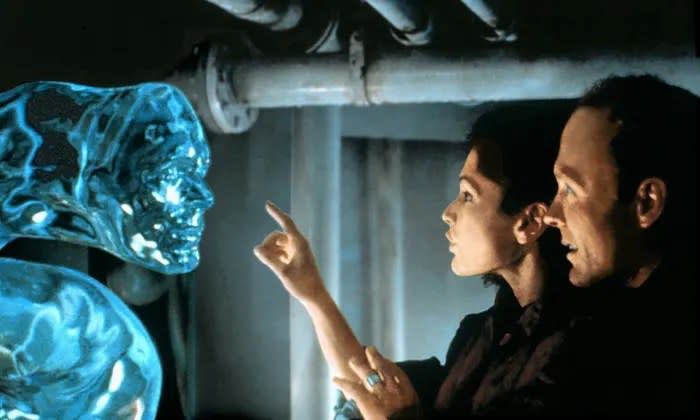James Cameron Says ‘The Abyss’ Wasn’t a ‘Slam Dunk’ Like His Previous Films: ‘The Studio Wasn’t Terribly Helpful’

- Oops!Something went wrong.Please try again later.
- Oops!Something went wrong.Please try again later.
James Cameron wasn’t as confident staring into “The Abyss” in 1989.
The Oscar winner explained during a Beyond Fest panel moderated by IndieWire’s Jim Hemphill that the underwater sci-fi action film was the “first really big, kind of mega-budget movie” in his career. Ed Harris and Mary Elizabeth Mastrantonio starred as divorced petroleum engineers who are hired to assist a Navy SEAL (Michael Biehn) in recovering a nuclear submarine. The 20th Century Fox film had a budget of $43 million and grossed $90 at the worldwide box office before winning the Academy Award for Best Visual Effects.
More from IndieWire
“Well, this was my first really big, kind of mega-budget movie,” Cameron said onstage. “It wasn’t kind of a slam dunk in the way ‘Aliens’ was. Like, we just knew ‘Aliens’ worked. This one, we didn’t know exactly how it was going to work.”
Cameron’s unease led to his first test screenings with audiences even after helming films like “The Terminator” and “Aliens.”
“We went out and tested it, and I was unfamiliar with the testing process. I had never done it before,” Cameron said. “We didn’t test ‘The Terminator.’ We didn’t test ‘Aliens.’ I never had to read cards and get feedback from a test audience. And in those days, you’d just go out in the boonies someplace and you’d do a test audience and it never kind of leaked out. There was no avenue for it to leak out.”
He continued, “The first major leaks came on ‘Titanic.’ Ain’t It Cool News? That’s the first time they started leaking information from test screenings, which was a big thing. But this was still where you thought you could sort of go out someplace and have like a little laboratory and get some market research.”
However, Cameron’s unfamiliarity with the process led to unexpected bumps: “I didn’t know how to read the cards. I didn’t know how to interpret the data. The studio wasn’t terribly helpful.”
The feedback from test audiences ultimately led to a key wave sequence being cut from the theatrical cut.
“I have to say what we went out and we actually screened it twice, once with the wave sequence in and once with it out, because […] the wave sequence wasn’t done,” Cameron said. “It was just a bunch of storyboards and you can’t ask a nonprofessional cinema audience to watch a movie where all of a sudden it just cuts to drawings. They don’t know how to process it. So of course the cards were bad for the wave sequence, and the cards were bad for the non-wave sequence. We kind of went, ‘Well, at least it’s shorter without the wave. At least it won’t cost as much to finish.’ I didn’t really know how to interpret the data, and I think we overreacted.”
The “Avatar” director added, “I’ve learned as a result of that how to interpret those cards, and what they really mean, and when to take it seriously, and when to just assume the movie’s not done yet, they’re not getting the full picture.”
By 1992, Cameron decided to finish the visual effects for the wave scene and “see what it looked like,” which he decided was a “better movie” than what was released in 1989.
“It’s the film I intended to make, if nothing else,” Cameron said. “But I actually think that you see how a lot of the film came together and how it truly is a proper heir apparent to ‘The Day the Earth Stood Still,’ which was what my intention was.”
A new 4K restoration of “The Abyss,” complete with the finished wave sequence, will be available soon in physical and streaming versions.
“All of the mastering is done and I think it drops pretty soon — a couple of months or something like that,” Cameron said. “There’s a lot of added material that they’re sticking in there, and it will be available on streaming simultaneously. But I didn’t just want to look at the old HD transfer. I wanted to do it right.”
Best of IndieWire
Nicolas Winding Refn's Favorite Films: 37 Movies the Director Wants You to See
The Best LGBTQ Movies and TV Shows Streaming on Netflix Right Now
Unsimulated Sex Scenes in Film: 'Nymphomaniac,' 'Brown Bunny,' 'Little Ashes,' and More
Sign up for Indiewire's Newsletter. For the latest news, follow us on Facebook, Twitter, and Instagram.

